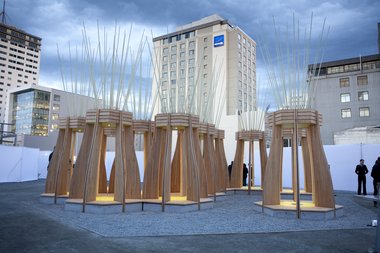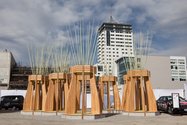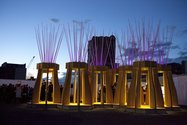Andrew Paul Wood – 12 October, 2013
To a certain extent, Morison's work has always been about manipulating and unsettling the perceptions of the viewer through artistic intervention inspired by the structures and systems human beings use. This artwork is a logical development of that into the third dimension and on a monumental scale with which Morison's work has rarely had play.
Christchurch
Julia Morison
Tree Houses For Swamp Dwellers
Portable but permanent public sculpture
Christchurch-based artist Julia Morison‘s contribution to the 2013 SCAPE Biennial of art in public space (September 27 - November 9) really highlights the design training that underpins the otherwise surrealistic vision of most of her work. The SCAPE Public Art Christchurch Biennial has been bringing its programme of interesting contemporary art in to the Garden City’s public spaces for over a decade and has made a remarkable recovery following the seismic upheavals of three years ago, continuing to provide quality cultural experiences despite all of the trials and tribulations.
Jointly funded by Todd Foundation’s Special Focus Fund for art projects and the Christchurch City Council, Tree Houses for Swamp Dwellers on the corner of Colombo and Gloucester Streets consists of ten modular, three metre tall, loosely bell-shaped hexagonal architectural timber forms on precast concrete bases, supporting coronae of LED illuminated fibreglass rods and container plantings of Muehlenbeckia complexa or maidenhair vine - a vigorously growing New Zealand native creeper that has become an invasive pest in other countries and which will eventually grow up the rods. The work blends together wood, masonry, living plants, and technology. The construction was sponsored by Hawkins Construction.
Launched on September 26, this, the first post-earthquake sculpture commissioned by the Christchurch Public Art Advisory Group, like many previous SCAPE projects, delineates discrete space within public space in a most ambiguous fashion. They suggest the current era’s fascination with pods and modules (especially those of the temporary pop up variety in Christchurch), and in a private setting might be mistaken for follies of some sort. In the public setting we are intended to read them as stylised trees-cum-play houses (shades, perhaps of the tree in which Peter Pan lived with the Lost Boys, a Smurf village, or at least a certain kind of childhood nostalgia and wonder).
The title Tree Houses for Swamp Dwellers is a direct reference to the locality’s previous status as swampland supporting forests of kahikatea or white pine like that preserved at Riccarton Bush - the only surviving example on the Canterbury Plains. The lurking presence of the swamp beneath the city was brought into sharp focus during the 2010 and 2011 Christchurch earthquakes in the form of liquefaction silt oozing up through the ground - a substance that has previously found its way into Morison’s work. The sculptures also totemically identify the part of the city designated as the future performing arts precinct in the Christchurch rebuild plan.
In terms of Morison’s broader oeuvre, these “trees” would seem to tie in with her interest in modularity and perhaps, given the artist’s interests in the traditions of Kabbalah, may tangentially allude to the Tree of the Sephiroth or Tree of Life. Hexagons, while a pragmatic engineering structure, also suggest an infinite expansion in infinite variation as in Jorge Luis Borges’ “Library of Babel”. As house forms they allude to the psychological utility of a roof over one’s head and the shortage of housing stock in Christchurch following the quakes.
One would also imagine that in the mists that Christchurch is prone to, the illuminated structures will look quite ethereal.
To a certain extent, Morison’s work has always been about manipulating and unsettling the perceptions of the viewer through artistic intervention inspired by the structures and systems human beings use. This artwork is a logical development of that into the third dimension and on a monumental scale with which Morison’s work has rarely had play. As an installation, the artworks exist in a status between permanent and temporary, designed to be permanent, but relocatable within the rapidly changing matrix of Christchurch’s evolving built environment.
Andrew Paul Wood





 Advertising in this column
Advertising in this column Two Rooms presents a program of residencies and projects
Two Rooms presents a program of residencies and projects



This Discussion has 0 comments.
Comment
Participate
Register to Participate.
Sign in
Sign in to an existing account.